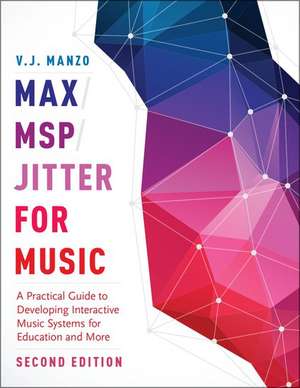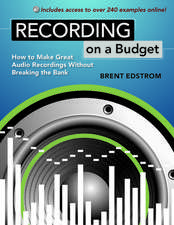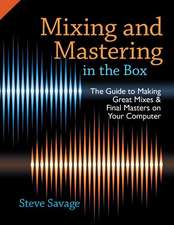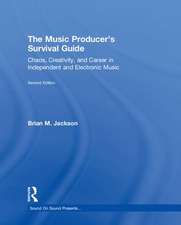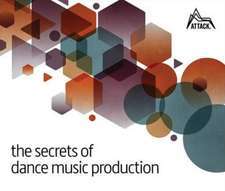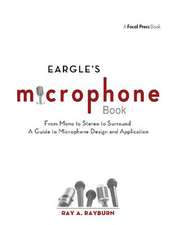Max/MSP/Jitter for Music: A Practical Guide to Developing Interactive Music Systems for Education and More
Autor V. J. Manzoen Limba Engleză Hardback – 8 sep 2016
| Toate formatele și edițiile | Preț | Express |
|---|---|---|
| Paperback (2) | 258.74 lei 31-37 zile | |
| Oxford University Press – 22 dec 2011 | 258.74 lei 31-37 zile | |
| Oxford University Press – 8 sep 2016 | 336.18 lei 31-37 zile | |
| Hardback (2) | 697.13 lei 31-37 zile | |
| Oxford University Press – 22 dec 2011 | 697.13 lei 31-37 zile | |
| Oxford University Press – 8 sep 2016 | 746.78 lei 31-37 zile |
Preț: 746.78 lei
Preț vechi: 995.61 lei
-25% Nou
Puncte Express: 1120
Preț estimativ în valută:
143.01€ • 145.94$ • 120.32£
143.01€ • 145.94$ • 120.32£
Carte tipărită la comandă
Livrare economică 14-20 februarie
Preluare comenzi: 021 569.72.76
Specificații
ISBN-13: 9780190243739
ISBN-10: 0190243732
Pagini: 434
Ilustrații: over 300 illustrations
Dimensiuni: 282 x 224 x 31 mm
Greutate: 1.46 kg
Ediția:2
Editura: Oxford University Press
Colecția OUP USA
Locul publicării:New York, United States
ISBN-10: 0190243732
Pagini: 434
Ilustrații: over 300 illustrations
Dimensiuni: 282 x 224 x 31 mm
Greutate: 1.46 kg
Ediția:2
Editura: Oxford University Press
Colecția OUP USA
Locul publicării:New York, United States
Recenzii
A groundbreaking, step-by-step approach to empowering the creativity of music educators and music students through interactive computer software design.
Max has become a major player in the world of music making and VJ Manzo's book is perfect for those who want to become fluent with the language. And, for the growing legions of music makers who are using clusters of applications for diverse projects, Manzo's clear categorization of Max functionality may well make this book an ongoing standard reference for building specific Max/MSP patches within each cluster.
This book is a lucid and systematic introduction for beginners or intermediate users to all three components of the popular multimedia software Max/MSP/Jitter, covering MIDI, basic programming concepts, real-time audio/video manipulation, camera tracking, and alternate controllers. VJ Manzo does an excellent job of clearly explaining how to use the software. Music educators, students, music technologists, sound designers, game developers, composers, and multimedia artists interested in learning Max in order to develop their own software applications will find this to be a highly useful text.
There are very few comprehensive resources out there for educators in music technology to get their students engaged in the creative act of writing software, as opposed to simply relying on commercial applications. This book, start to finish, provides a thorough curriculum for using Max in a music education setting, nicely complementing the company's own documentation by showing how to build more complex projects that integrate interactivity and sound. Manzo's book is a great read, not only for educators and students but for electronic musicians looking to expand their arsenal of expressive tools.
Max has become a major player in the world of music making and VJ Manzo's book is perfect for those who want to become fluent with the language. And, for the growing legions of music makers who are using clusters of applications for diverse projects, Manzo's clear categorization of Max functionality may well make this book an ongoing standard reference for building specific Max/MSP patches within each cluster.
This book is a lucid and systematic introduction for beginners or intermediate users to all three components of the popular multimedia software Max/MSP/Jitter, covering MIDI, basic programming concepts, real-time audio/video manipulation, camera tracking, and alternate controllers. VJ Manzo does an excellent job of clearly explaining how to use the software. Music educators, students, music technologists, sound designers, game developers, composers, and multimedia artists interested in learning Max in order to develop their own software applications will find this to be a highly useful text.
There are very few comprehensive resources out there for educators in music technology to get their students engaged in the creative act of writing software, as opposed to simply relying on commercial applications. This book, start to finish, provides a thorough curriculum for using Max in a music education setting, nicely complementing the company's own documentation by showing how to build more complex projects that integrate interactivity and sound. Manzo's book is a great read, not only for educators and students but for electronic musicians looking to expand their arsenal of expressive tools.
Notă biografică
V.J. Manzo is Assistant Professor of Music Technology and Perception at Worcester Polytechnic Institute. He is a composer and guitarist with research interests in theory and composition, artificial intelligence, interactive music systems, and music cognition.
